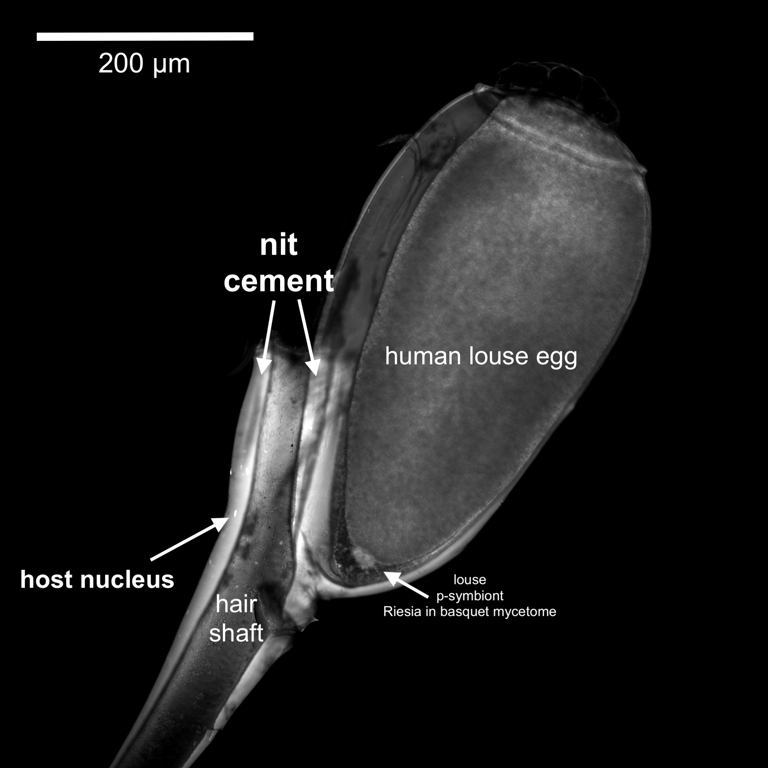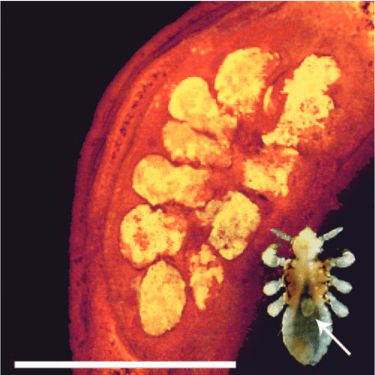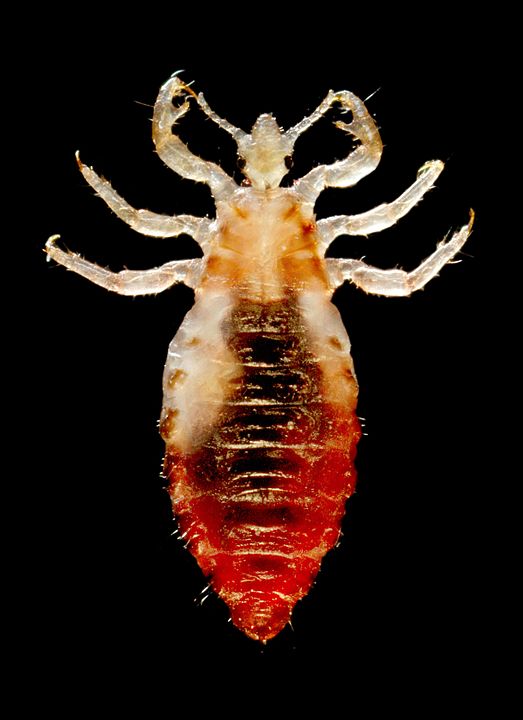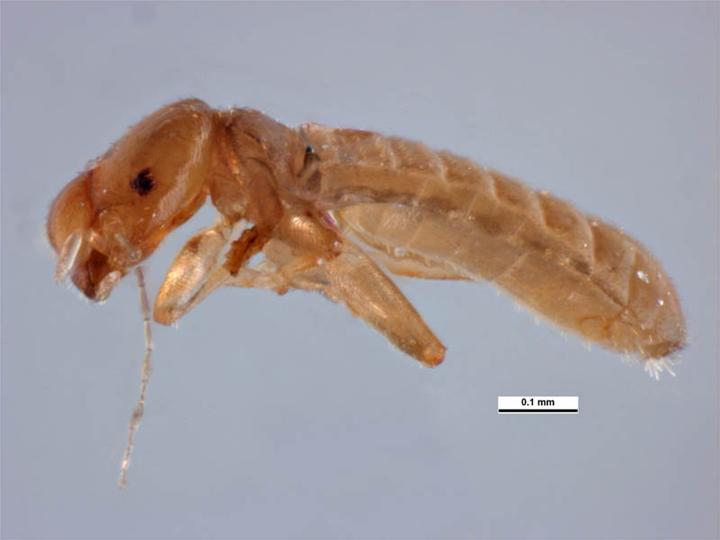Lice and Booklice
Perotti MA, Allen JM, Reed DL, & Braig HR. 2007
Host-symbiont interactions of the primary endosymbiont of human head and body lice.
FASEB Journal 21, 1058-1066.
The first mycetome was discovered more than 340 yr ago in the human louse. Despite the remarkable biology and medical and social importance of human lice, its primary endosymbiont has eluded identification and characterization. Here, we report the host-symbiont interaction of the mycetomic bacterium of the head louse Pediculus humanus capitis and the body louse P. h. humanus. The endosymbiont represents a new bacterial lineage in the γ-Proteobacteria. Its closest sequenced relative is Arsenophonus nasoniae, from which it differs by more than 10 %. A. nasoniae is a male-killing endosymbiont of jewel wasps. Using microdissection and multiphoton confocal microscopy, we show the remarkable interaction of this bacterium with its host. This endosymbiont is unique because it occupies sequentially four different mycetomes during the development of its host, undergoes three cycles of proliferation, changes in length from 2– 4 m to more than 100 m, and has two extracellular migrations, during one of which the endosymbionts have to outrun its host’s immune cells. The host and its symbiont have evolved one of the most complex interactions: two provisional or transitory mycetomes, a main mycetome and a paired filial mycetome. Despite the close relatedness of body and head lice, differences are present in the mycetomic provisioning and the immunological response.






Pedersen MW, Antunes C, De Cahsan B, Moreno-Mayar JV, Sikora M, Vinner L, Mann D, Klimov PB, Black S, Michieli CT, Braig HR, & Perotti MA. 2022
Ancient human genomes and environmental DNA from the cement attaching 2,000 year-old head lice nits.
Molecular Biology and Evolution 39, msab351.
Over the past few decades, there has been a growing demand for genome analysis of ancient human remains. Destructive sampling is increasingly difficult to obtain for ethical reasons, and standard methods of breaking the skull to access the petrous bone or sampling remaining teeth are often forbidden for curatorial reasons. However, most ancient humans carried head lice and their eggs abound in historical hair specimens. Here we show that host DNA is protected by the cement that glues head lice nits to the hair of ancient Argentinian mummies, 1,500–2,000 years old. The genetic affinities deciphered from genome-wide analyses of this DNA inform that this population migrated from north-west Amazonia to the Andes of central-west Argentina; a result confirmed using the mitochondria of the host lice. The cement preserves ancient environmental DNA of the skin, including the earliest recorded case of Merkel cell polyomavirus. We found that the percentage of human DNA obtained from nit cement equals human DNA obtained from the tooth, yield 2-fold compared with a petrous bone, and 4-fold to a bloodmeal of adult lice a millennium younger. In metric studies of sheaths, the length of the cement negatively correlates with the age of the specimens, whereas hair linear distance between nit and scalp informs about the environmental conditions at the time before death. Ectoparasitic lice sheaths can offer an alternative, non-destructive source of high-quality ancient DNA from a variety of host taxa where bones and teeth are not available and reveal complementary details of their history.
Perotti MA, Clarke HK, Turner BD, & Braig HR. 2006
Rickettsia as obligate and mycetomic bacteria.
FASEB Journal 20, 2372-2374.
Rickettsiae are well known as intracellular pathogens of animals, humans, and plants and facultative and unorganized symbionts of invertebrates. No close relative of mitochondria has yet been associated with nutritional or developmental dependency of its host cell or organism. We have found a mycetomic Rickettsia that is a strict obligatory symbiont of the parthenogenetic booklouse Liposcelis bostrychophila (Psocoptera). These rickettsiae show an evolutionary transition from a solitary to a primary mycetomic bacterium adapted to the development of its host. These intracellular and intranuclear bacteria reside in specialized cells in several tissues. Their distribution changes markedly with the development of their host. The most advanced phenotype is a paired mycetome in the abdomen, described for the first time for Rickettsia and this host order. The mycetomic rickettsiae of two parthenogenetic book lice species are in the spotted fever group and in the basal limoniae group. While mycetomic bacteria are well known for their metabolic or light-emitting functions, these rickettsiae have an essential role in the early development of the oocyte. Removal of the Rickettsia stops egg production and reproduction in the book louse. In two phylogenetically distant psocopteran species, Rickettsia are shown to be associated with four transitional stages from free bacteria, infected cells, through single mycetocytes to organ-forming mycetomes.
Kirkness EF, Haas BJ, Sun W, Braig HR, Perotti MA, Clark JM, ..., & Pittendrigh BR. 2010
Genome sequences of the human body louse and its primary endosymbiont provide insights into the permanent parasitic lifestyle.
Proceedings of the National Academy of Sciences of the United States of America 107, 12168-12173.
As an obligatory parasite of humans, the body louse (Pediculus humanus humanus) is an important vector for human diseases, including epidemic typhus, relapsing fever, and trench fever. Here, we present genome sequences of the body louse and its primary bacterial endosymbiont Candidatus Riesia pediculicola. The body louse has the smallest known insect genome, spanning 108 Mb. Despite its status as an obligate parasite, it retains a remarkably complete basal insect repertoire of 10,773 protein-coding genes and 57 microRNAs. Representing hemimetabolous insects, the genome of the body louse thus provides a reference for studies of holometabolous insects. Compared with other insect genomes, the body louse genome contains significantly fewer genes associated with environmental sensing and response, including odorant and gustatory receptors and detoxifying enzymes. The unique architecture of the 18 minicircular mitochondrial chromosomes of the body louse may be linked to the loss of the gene encoding the mitochondrial single-stranded DNA binding protein. The genome of the obligatory louse endosymbiont Candidatus Riesia pediculicola encodes less than 600 genes on a short, linear chromosome and a circular plasmid. The plasmid harbors a unique arrangement of genes required for the synthesis of pantothenate, an essential vitamin deficient in the louse diet. The human body louse, its primary endosymbiont, and the bacterial pathogens that it vectors all possess genomes reduced in size compared with their free-living close relatives. Thus, the body louse genome project offers unique information and tools to use in advancing understanding of coevolution among vectors, symbionts, and pathogens.


Image: K. Walker
Perotti MA, Catalá SS, Ormeño AD, Zelazowska M, Bilinski SM, & Braig HR. 2004
The sex ratio distortion in the human head louse is conserved over time.
BMC Genetics 5, e10.
Background: At the turn of the 19th century, the first observations of a female-biased sex ratio in broods and populations of the head louse, Pediculus humanus capitis, had been reported. A study by Buxton in 1940 on the sex ratio of lice on prisoners in Ceylon is still today the subject of reanalyses. This sex ratio distortion had been detected in ten different countries. In the last sixty years no new data have been collected, especially on scalp infestations under economically and socially more developed conditions.
Results: Here we report a female bias of head lice in a survey of 480 school children in Argentina. This bias is independent of the intensity of the pediculosis, which makes local mate competition highly unlikely as the source of the aberrant sex ratio; however, other possible adaptive mechanisms cannot be discounted. These lice as well as lice from pupils in Britain were carrying several strains of the endosymbiotic bacterium Wolbachia pipientis, one of the most wide-spread intracellular sex ratio distorters. Similar Wolbachia strains are also present in the pig louse, Haematopinus suis, suggesting that this endosymbiont might have a marked influence on the biology of the whole order. The presence of a related obligate nutritional bacterium in lice prevents the investigation of a causal link between sex ratio and endosymbionts.
Conclusions: Regardless of its origin, this sex ratio distortion in head lice that has been reported world-wide, is stable over time and is a remarkable deviation from the stability of frequency-dependent selection of Fisher's sex ratio. A female bias first reported in 1898 is still present over a hundred years and a thousand generations later.

